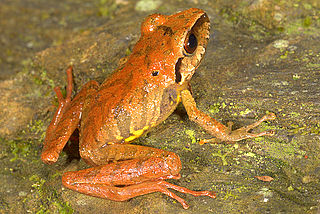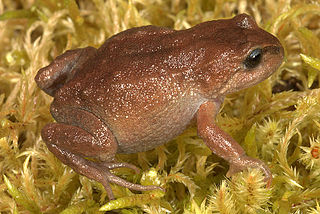Nymphargus chancas is a species of frog in the family Centrolenidae. Until recently it was only known from its type locality in the Lamas Province in Peru; however, it is now known to occur more widely in the northern San Martín Region of Peru, extending into the Cordillera del Cóndor in Zamora-Chinchipe Province, Ecuador.

Callimedusa atelopoides is a species of frog in the subfamily Phyllomedusinae. It is known from Amazonian Bolivia, Brazil, and Peru, and is likely to be found in adjacent Colombia and Ecuador. Common name toady leaf frog has been proposed for it.
Pristimantis ceuthospilus is a species of frog in the family Strabomantidae. It is endemic to northern Peru and occurs on the western slopes of the Cordillera de Huancabamba and the Pacific slope of the Cordillera Occidental. There are also as yet unconfirmed records from southern Ecuador. The specific name ceuthospilus, from Greek keuthos ("hidden") and spilos ("spot"), refers to the yellow spots in the groin and thighs that remain hidden when the frog is sitting. Common name Wild's robber frog has been coined for it.

Pristimantis danae is a species of frog in the family Strabomantidae, sometimes known as Cuzco robber frog. It is found in the Andes between southern Peru and north-western Bolivia. It is named after the daughter of the author, Dana K. Duellman, who helped in collecting the frogs. Pristimantis reichlei, described in 2009, was previously confused with Pristimantis danae.
Oreobates lundbergi is a species of frogs in the family Strabomantidae. It is endemic to central Peru and is known from the Amazonian slopes of the Cordillera Oriental in the Paucartambo District, Pasco.
Pristimantis rhodoplichus, also known as the Canchaque robber frog, is a species of frog in the family Strabomantidae. It is found in the Andes of southern Ecuador and northern Peru. The specific name rhodoplichus, from the Greek rhodon and plichas, refers to the rose-red color of the hidden surfaces of its thighs.
Oreobates zongoensis is a species of frog in the family Strabomantidae. It is endemic to Bolivia from Valle del Zongo, in Pedro Domingo Murillo Province.
Gastrotheca abdita is a species of frog in the family Hemiphractidae. It is endemic to Peru and only known from the Cordillera Colán in the Amazonas Region. The specific name abdita is Latin for "exiled" or "removed" and refers to the geographic isolation of the Cordillera Colán. Common name Cordillera Colan marsupial frog has been coined for it.

Bryophryne cophites, also known as the Cusco Andes frog or the Cuzco Andes frog, is a species of frog in the family Strabomantidae. It is endemic to Peru and known only from slopes of the Abra Acanacu in the Cordillera de Paucartambo, Cusco Region. There is an unconfirmed record from a neighboring mountain range, so this species might be more widespread than current knowledge suggests.
Phrynopus dagmarae is a species of frog in the family Strabomantidae. It is endemic to the Andes of Peru and only known from the Pachitea and Ambo Provinces in the Huánuco Region, from near the type locality. The specific name dagmarae honors Dagmar Schramm from Germany.

Lynchius flavomaculatus, also known as the yellow-spotted Andes frog, is a species of frog in the family Strabomantidae. It is found in the Andes of southern Ecuador and northern Peru.
Niceforonia lucida is a species of frog in the family Strabomantidae. It is endemic to Peru and known from the Cordillera Central west of the Apurímac River in the Ayacucho Region. Common name Cannatella's Andes frog has been coined for it. The specific name lucida refers to distinctive coloration of this frog relative to frogs in the genus Phrynopus, the genus where this species was initially placed. However, later studies have moved it to other genera where its colors are less distinctive.
Oreobates pereger, also known as the Ayacucho Andes frog, is a species of frog in the family Strabomantidae. It is endemic to Peru where it is known from the eastern slopes of the Cordillera Oriental and Cordillera Vilcabamba mountain ranges.

Engystomops coloradorum, also known as Colorado dwarf frog, is a species of frogs in the family Leptodactylidae. It is endemic to the Pacific lowlands and foothills of the Andes in the Pichincha and Santo Domingo de los Tsáchilas Provinces, Ecuador.
Telmatobius ignavus is a species of frog in the family Telmatobiidae. It is endemic to the Cordillera de Huancabamba in the Department of Piura, Peru. Common name Piura water frog has been coined for it.
Barygenys cheesmanae is a species of frogs in the family Microhylidae. It is endemic to eastern New Guinea and is only known from Mount Tafa in Central Province, Papua New Guinea. The specific name cheesmanae honors Lucy Evelyn Cheesman, an English entomologist, explorer, curator at London Zoo, and collector of the holotype. Common name Cheesman's Papua frog has been coined for this species.
Atelopus pyrodactylus is a species of toad in the family Bufonidae. It is endemic to Peru and only known from its type locality in the northern section of the Río Huallaga basin, Department of San Martín, on the eastern slope of the Cordillera Central. The specific name pyrodactylus refers to the light orange fingers and toes of this frog.
Phrynopus tribulosus is a species of frog in the family Strabomantidae. It is endemic to Peru and only known from its type locality near Oxapampa at 2,600 m (8,500 ft) asl, and from Santa Bárbara, in the Huancabamba District, Oxapampa, Pasco Region. It inhabits humid montane forests where individuals could be found deep within a mossy bank by day.

Lynchius is a genus of frogs in the family Strabomantidae. The name honours herpetologist John D. Lynch. The distribution of Lynchius is restricted to the Cordillera Oriental in southern Ecuador and Cordillera de Huancabamba in northern Peru.

Niceforonia is a genus of frogs in the family Strabomantidae found in northern South America. The name refers to Nicéforo María, Colombian herpetologist.






